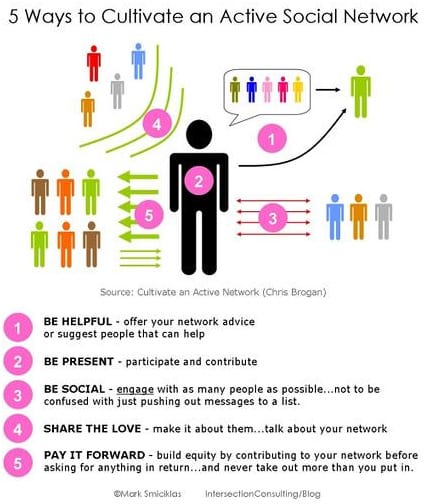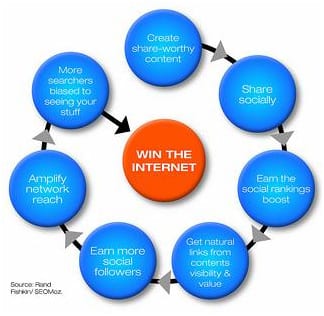Where do you start when seeking to establish your social networks
While much of the social media marketing advice on Smart Insights gives advice on social media best practices for companies that are already set up on social networks, some businesses are still venturing onto social platforms for the first time. If this is relevant for you or your clients, this introductory post is for you.
Understand how and when your users use social networks
If you’re online a lot you will probably have an innate built in idea of the demographics on the different platforms. If you are new to social you will need to do a bit of research beforehand. See these top 10 sources of digital marketing statistics or this free 2013 digital media usage data from comScore for useful research into how different ages and genders use different social networks.
You also need to bear in mind how accessible these audiences are. The great thing about Twitter is that you can literally follow and converse with anyone as long as their accounts are not padlocked.
In comparison on Facebook you need to get your audience’s attention and get them to interact with you without having the ability of being able to socially stalk them beforehand. And let’s not forget Google+ as you can connect with anyone on here a bit like on Twitter yet this platform may well, (as mentioned in their blog), have the further positive effect of improving other areas of your marketing plan.
When you have decided where you want your presences, put some time and thought into page branding. Try and stay uniform with the urls you use for each.Where possible try and get the same url endings for each of the platforms you are setting up.
This can prove difficult if you have a longer brand name or if there are others out there with the same brand name as your business, who have already got their hands on the url’s you might have wanted.
Once you have the name in place it might seem obvious but for consistency it helps to keep the branding the same over the different platforms so that your followers don’t get confused.
There are no quick fixes to this stage. In my opinion, buying likes and follows is not a viable long term option and is something you are sure to get penalised for if you are found out! This is going to be the time consuming part of running your campaign.
Before you begin, here are a few questions you can ask yourself to start narrowing down your target audience:
- Who are you targeting? Individuals, companies or both?
- Who are your competitors? Can you tap to into their social following?
- Who are your advocates or business partners? Can they help spread your message?
- Who are your peers or experts in your field? Would having positive interactions with them help with your social promotion?
- Where are your customers geographically? Would targeting specific areas be more beneficial for your business?
This should give you some idea of where to start to begin building your audience. When you have answered and identified these people and companies online,you will be ready to begin sharing your content, building relationships and creating a trusted brand.
The next step is to get your message out. You have identified your audience; you now need to get their attention by sharing your great content, other peoples' content that is of interest to your industry, and also interacting and creating conversations. You may want to schedule some of the updates you are putting out for ease but remember social networks are primarily ‘social’ and without human interaction you will not achieve your business objectives.
Hootsuite allows you to share your content easily across the different channels and will auto schedule your posts so you can be sure they are going out to your different networks at the optimum time when more of your audience is online. This said you should still make sure your content is tailored to the network you are updating.
There are many ways to fire up the interaction. Here are some ideas for starters:
- Set up a Twitter DM with a link to your Facebook page to encourage your followers to visit
- Set up a Twitter competition asking people to upload pictures of your products. (Last time I was in Pizza Express I uploaded a picture of their calzone pizza to their Twitter with the hashtag #sealofapproval, in the hope of winning a holiday).
- Set up a Facebook offer with money off a product.
- Get your business listed on Foursquare and offer a discount when people check in
But ultimately for lead generation and customer conversion you need to be part of the conversation and by doing so you will begin to find new customers who are willing to advocate your brand online, as this case study for Renaissance hair and beauty demonstrates.

The picture is supplied by Flickr.
ROI from social media is a difficult volume to measure. It is easy to count and report on how many people clicked on a Facebook offer and how this converted to sales as the systems are already set up within the Facebook platform. On the other hand It is more difficult to measure the people who initially found your brand on one of the social platforms and the journey they took before coming to your website to buy your products.
It is important therefore to define what it is you are going to measure when you first start your campaign, as you are then able to set specific goals and metrics for monitoring.
When you initially start your campaign your measurements may well be based around numbers of new likes and follows. As your campaigns begin to grow you can start factoring social shares, rt’s and conversations and as you amass a number of users you will find you have a lot more data which will offer further insights.
Some of the social networks have in built analytics, by far the best of these in my opinion is Youtube, and I am sure being owned by Google goes some way toward its superior built in analytics.
Facebook analytics go some way to give you audience insight into reach and shares. Utilising adverts and promoted posts will give you a further understanding of your content and how it is working for your audience. Analysing this data, A and B testing and tweaking will allow you to fine tune your content for your audience. If for example, your goal is to push traffic to your website for data capture; using shortened links can provide important CTR data for you to monitor which social platforms are pushing the most traffic.
One thing to bear in mind is that if you are a marketer you will understand the value of a RT or a new like, but your clients most likely won’t. Where possible, when reporting to your clients try and use metrics that they will understand, for example the CTR, CPI and the size of the audience or reach and levels of engagement.
If a client expects that they are going to get paying customers overnight as a result of a social campaign, it is unlikely that this is the correct channel for them to pursue. If however they are forward thinkers and want to establish their online presence, build brand awareness and invest in a digital strategy that will have a long term affect on their online presence, and ultimately (as Gavin Llewellyn’s infographic describes as) ‘Win the internet’ then using social media will put them in exactly the right arena.

 Thanks to Jane Nriapia for sharing her advice and opinions in this post. Jane is a Director and Online Marketing Consultant at Cloud9 Web Solutions, and her main area of expertise is social media. She was an early adopter of Facebook and through hands on experience she began to integrate her love for social into her job in corporate responsibility. Her passion for social quickly evolved into a passion for blogging, and when the blogging bug got her, Jane decided it was time to leave the corporate world where she had spent over 15 years, and start her own business providing social media management to business. You can connect with her on LinkedIn or Google+ or follow her on Twitter.
Thanks to Jane Nriapia for sharing her advice and opinions in this post. Jane is a Director and Online Marketing Consultant at Cloud9 Web Solutions, and her main area of expertise is social media. She was an early adopter of Facebook and through hands on experience she began to integrate her love for social into her job in corporate responsibility. Her passion for social quickly evolved into a passion for blogging, and when the blogging bug got her, Jane decided it was time to leave the corporate world where she had spent over 15 years, and start her own business providing social media management to business. You can connect with her on LinkedIn or Google+ or follow her on Twitter.





 Thanks to Jane Nriapia for sharing her advice and opinions in this post. Jane is a Director and Online Marketing Consultant at
Thanks to Jane Nriapia for sharing her advice and opinions in this post. Jane is a Director and Online Marketing Consultant at 


